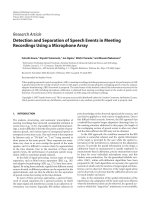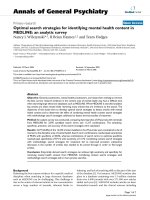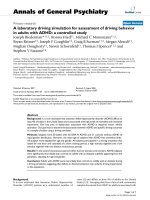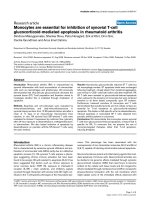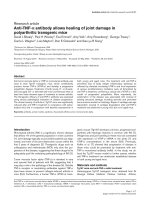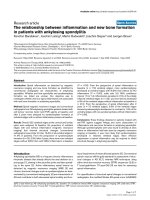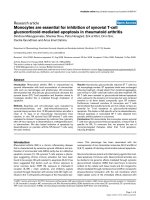Báo cáo y học: " laboratory driving simulation for assessment of driving behavior in adults with ADHD: a controlled study" docx
Bạn đang xem bản rút gọn của tài liệu. Xem và tải ngay bản đầy đủ của tài liệu tại đây (244.32 KB, 7 trang )
BioMed Central
Page 1 of 7
(page number not for citation purposes)
Annals of General Psychiatry
Open Access
Primary research
A laboratory driving simulation for assessment of driving behavior
in adults with ADHD: a controlled study
Joseph Biederman*
†1,2
, Ronna Fried
†1
, Michael C Monuteaux
†1,2
,
Bryan Reimer
†3
, Joseph F Coughlin
†3
, Craig B Surman
†1,2
, Megan Aleardi
†1
,
Meghan Dougherty
†1
, Steven Schoenfeld
†1
, Thomas J Spencer
†1,2
and
Stephen V Faraone
†4
Address:
1
Pediatric Psychopharmacology Department at Massachusetts General Hospital in Boston, MA, USA,
2
Department of Psychiatry at the
Harvard Medical School, Boston MA, USA,
3
MIT Center for Transportation & Logistics, 77 Massachusetts Avenue, E40-276 Cambridge, MA 02139,
USA and
4
Medical Genetics Research Center and Department of Psychiatry, SUNY Upstate Medical University, Syracuse, NY, USA
Email: Joseph Biederman* - ; Ronna Fried - ; Michael C Monuteaux - ;
Bryan Reimer - ; Joseph F Coughlin - ; Craig B Surman - ;
Megan Aleardi - ; Meghan Dougherty - ; Steven Schoenfeld - ;
Thomas J Spencer - ; Stephen V Faraone -
* Corresponding author †Equal contributors
Abstract
Background: It is now estimated that attention deficit-hyperactivity disorder (ADHD) afflicts at
least 4% of adults in the United States and is associated with high levels of morbidity and functional
impairment. One key area of dysfunction associated with ADHD is impaired motor vehicle
operation. Our goal was to examine the association between ADHD and specific driving outcomes
in a sample of adults using a driving simulator.
Methods: Subjects were 20 adults with full DSM-IV ADHD and 21 controls without ADHD of
equal gender distribution. However, the mean age of subjects with ADHD was somewhat older.
All analyses were adjusted for age and gender. All subjects participated in a driving simulation that
lasted for one hour and consisted of a short training period, a high stimulus segment and a low
stimulus segment with two distinct monotonous periods.
Results: In the second monotonous period within the low stimulus environment, ADHD subjects
were significantly more likely than controls to collide with an obstacle suddenly appearing from the
periphery, adjusting for age and gender.
Conclusion: Adults with ADHD were more likely than controls to collide with an obstacle during
a driving simulation suggesting that deficits in directed attention may underlie driving impairments
in this population.
Background
It is now estimated that Attention Deficit Hyperactivity
Disorder (ADHD) persists in a substantial number of
cases [1] and afflicts at least 4% of adults in the United
States [2,3]. Emerging data from clinical and community
samples document that ADHD in adults is associated with
Published: 30 January 2007
Annals of General Psychiatry 2007, 6:4 doi:10.1186/1744-859X-6-4
Received: 9 August 2006
Accepted: 30 January 2007
This article is available from: />© 2007 Biederman et al., licensee BioMed Central Ltd.
This is an open access article distributed under the terms of the Creative Commons Attribution License ( />),
which permits unrestricted use, distribution, and reproduction in any medium, provided the original work is properly cited.
Annals of General Psychiatry 2007, 6:4 />Page 2 of 7
(page number not for citation purposes)
high levels of morbidity and functional impairment [4,5].
One key area of dysfunction associated with ADHD is
impaired motor vehicle operation. Driving accidents are a
major public health concern being one of the leading
causes of death in the United States as of 2003 [6].
An emerging literature shows that drivers with ADHD are
more likely than drivers without ADHD to commit traffic
violations and have adverse driving outcomes. A follow-
up of adolescents and young adults with and without
ADHD found those with ADHD were more likely to be
involved in traffic accidents, to be at fault in automobile
accidents and to have received more traffic citations than
controls [7]. Another follow-up study reported that
ADHD subjects were more likely to incur more significant
damage to their vehicles in crashes than normal controls
[8] indicating more severe accidents. Likewise, two epide-
miological longitudinal studies of New Zealander adoles-
cents reported that individuals with ADHD had
significantly more driving transgressions than controls [9]
and were at a greater risk to have traffic accidents involv-
ing injuries and traffic violations [10].
Furthermore, documentation through surveys and RMV
questionnaires has shown that individuals with ADHD
have worse driving histories than subjects with other psy-
chiatric disorders [11] and display significantly worse safe
driving habits than matched controls [7,12]. Reimer et al.
[13] compared the driving behavior of subjects with and
without ADHD on the Manchester Driving Behavior
Questionnaire (DBQ) and a driving history question-
naire. Results documented that adult ADHD subjects
scored significantly worse than non-ADHD subjects on all
aspects indexing impaired driving behavior. Although
very informative, these questionnaire-based studies pro-
vide limited understanding as to the underlying compo-
nents of impaired driving associated with ADHD.
In recent years driving simulator paradigms have been
developed to help quantify key components of driving
behaviors among individuals with ADHD [14,15]. These
studies failed to fully establish the validity of the driving
simulation paradigm used, [16] making it difficult to
interpret their results.
To address the limitations of the extant literature, our
group has developed and validated a novel driving simu-
lator paradigm for the study of impaired driving behavior
in individuals with ADHD [17]. Convergent validity was
assessed through a comparison of self-reported behaviors
such as traffic tickets and accidents with simulated out-
comes; discriminate validity was assessed through a multi-
trait, multi-method matrix and concurrent validity was
established through the analysis of accident rates between
ADHD subjects and controls in the driving simulator.
This new paradigm was designed to assess the core com-
ponents of the clinical picture of ADHD that could
account for driving impairments in individuals with
ADHD. Therefore proxies of impulsivity, hyperactivity
and inattention were incorporated into the development
of the driving paradigm. To assess inattention, the driving
simulation included a monotonous driving period punc-
tuated with a sudden peripheral stimulus (a dog running
into the road). Such a setting was designed to mimic a
non-stimulating section of highway situation whereby
individuals with ADHD become bored and become less
attentive. To assess impulsivity, the simulator included a
slow moving lead vehicle and assessed whether the drivers
could tolerate not passing the vehicle through the fre-
quency of lane departures indexing passing attempts.
Hyperactivity was assessed through the logging of driving
speed throughout the simulation as well as rate of stop-
ping before a traffic light or stop sign.
The main purpose of this study was to evaluate the driving
impairments in individuals with ADHD using this new
well-developed and ecologically valid paradigm. We
hypothesized that ADHD drivers will show specific driv-
ing impairments associated with the proxies indexing the
core features of ADHD: inattention, hyperactivity and
impulsivity.
Methods
Subjects
Subjects were 20 adults with DSM-IV ADHD and 21 con-
trols without ADHD of equal gender distribution. How-
ever, the mean age of subjects with ADHD was somewhat
older. All analyses were adjusted for age and gender simi-
lar age and sex. All ADHD subjects met full DSM-IV crite-
ria and had symptom onset in childhood and persistent
symptomatology into adulthood. ADHD subjects with
and without prior histories of treatment for the condition
were included. Controls were included if they failed to
meet criteria for ADHD and endorsed fewer than 3 ADHD
symptoms at any level of severity. Participants were
required to be English speakers. Excluded were subjects
with an IQ less than 80. Subjects were recruited through
clinical referrals to an adult ADHD program at a major
medical center and through advertisement in local media.
The local institutional review board approved this study
and all subjects provided written informed consent for
participation.
Clinical assessments
Diagnostic assessment relied on the Structured Clinical
Interview for DSM-IV [18] supplemented for childhood
disorders by modules from the Kiddie Schedule for Affec-
tive Disorders and Schizophrenia for School-Age Chil-
dren-Epidemiologic Version [19]. Raters performing
assessments and interviews were blind to the ascertain-
Annals of General Psychiatry 2007, 6:4 />Page 3 of 7
(page number not for citation purposes)
ment status of the probands. Socioeconomic status (SES)
was assessed with the Hollingshead four-factor scale [20].
To have been given a full diagnosis of adult ADHD, the
subject must have (1) met full DSM-IV criteria (at least 6
of 9 symptoms) for inattentive or hyperactive/impulsive
subtypes, with the onset of multiple symptoms by age 7
years; (2) described a chronic course of ADHD symptoms
from childhood to adulthood; and (3) endorsed a moder-
ate or severe level of impairment attributed to the ADHD
symptoms.
To elicit ADHD symptomatology, we used the ADHD
module from the Kiddie SADS-E, wording questions to
inquire if symptoms in childhood were currently present,
and then asking whether the symptoms were present cur-
rently to a clinically meaningful degree. By using this
method, we assured that the syndrome observed in adult-
hood had some continuity with the syndrome reported in
childhood.
Driving simulator
The driving simulator used an instrumented full cab 2001
Volkswagen Beetle with a front projection screen that pro-
vided the driver with a near 40-degree view of virtual road-
way. The original equipment manufacture (OEM)
accelerator, brake, and steering wheel recorded inputs
from the driver. Driving simulation software used STISEM
Drive and STISIM Open Module to compute graphical
updates, based upon a validated driving simulation [17].
The driving simulation lasted for one hour and consisted
of three segments consisting of a training period, a high-
stimulus testing period and a low-stimulus testing period.
There was a slight pause between each segment.
The training segment provides subjects with an approxi-
mately 10 minute driving period to become acclimated to
the simulated driving environment [17]. The protocol was
designed so that a driver closely monitoring the appropri-
ate speed limit would drive for approximately 45 minutes.
The high stimulus portion of the protocol included fea-
tures of urban driving, such as traffic lights, stop signs, jay-
walkers and parked cars pulling out into traffic. Posted
speed limits were between 45 and 35 MPH. The car-fol-
lowing condition introduced low-stimulus driving with
oncoming traffic to constrain the driver to follow a lead
vehicle with a velocity changing according to a sinusoidal
function with mean 35 mph. The behaviors measured
during this period were designed as a proxy of impulsivity.
In the low stimulus portion of the protocol two "monot-
onous" segments, described in more detail below, are sep-
arated by a rural road with hills and curves and a four lane
highway. The rural road included incidences where an on
coming vehicle suddenly invaded the driver's lane and a
slow vehicle appeared in front of the driver. The highway
provided drivers with the opportunity to follow or pass
surrounding traffic. The posted speed limits in the rural
and highway sections were 55 MPH and 65 MPH respec-
tively. For further details on the components of the simu-
lation refer to Reimer et al. [17].
As mentioned earlier, the first and last portions of the low-
stimulus testing period included "monotonous" segments
where the driver travels for two miles along a two-lane
highway with a posted speed limit of 55 MPH without
oncoming traffic. The low-stimulus segments of monoto-
nous driving were punctuated with a sudden peripheral
stimulus in the form of a dog, which appears 60 feet off
the right side of the roadway and 350 feet ahead. The dog
moved toward the road at 18 feet per second. To avoid
impacting driver's subsequent performance by a collision,
no major action was required to avoid collision in the first
presentation of the dogs. During the second presentation
of the stimulus, however, the timing of the dogs was such
that major evasive action was required to avert a collision.
When entering the car, drivers were instructed on proce-
dures for adjusting the seat, the visual presentation of the
rearview mirror and using the OEM speedometer. Partici-
pants were told that they would receive a base compensa-
tion of $40 for their participation. Finally, to encourage
subjects to obey traffic laws, while balancing the need to
drive at an appropriate speed, a two part financial incen-
tive structure was presented [17,21]. Participants were
instructed that they had 45 minutes to complete the
experimental portion of the simulation and that $1 would
be deducted from a $20 bonus for each minute they were
late. Additionally, participants were told that they would
be penalized $5 for each crash and $1 for each traffic ticket
(speeding, reckless driving, running stop signs and traffic
lights) from a second $20 bonus.
Driver performance was categorized across a number of
parameters: velocity, lane position, reaction time and a
binary measure of collision with the sudden peripheral
stimulus. Velocity was measured as the maximum velocity
reached by the driver, relative to the posted speed limit.
This aspect of driving behavior was measured as a proxy of
hyperactivity. Lane position was measured as the variabil-
ity of the driver's position within lane. Reaction time was
measured as the time from the start of any sudden move-
ment of the steering wheel or depression of the brake
pedal and rate of stopping before a traffic light or stop sign
was also designed to be a proxy of hyperactivity.
Statistical analyses
Demographic variables were analyzed using two-sample t-
tests and Pearson's chi-squared test for continuous and
binary outcomes, respectively. Driving outcomes were
assessed with a series of linear and logistic regression
Annals of General Psychiatry 2007, 6:4 />Page 4 of 7
(page number not for citation purposes)
models for continuous and binary outcomes, respectively,
with the driving outcome as the dependent variable and
ADHD status and any confounding factors as the inde-
pendent variables. As an exploratory analysis, we repeated
these regressions, modeling the driving outcomes as a
function of ADHD status, gender, and the ADHD-by-gen-
der interaction. The interaction tests if the association
between ADHD and the driving outcome differs by gen-
der. If the interaction term is significant, we estimated the
ADHD effect within stratum of gender. This interaction
analysis was repeated using ADHD status, age (18-2 ver-
sus 27–51) and the ADHD-by-age interaction as inde-
pendent variables. Alpha was set at 0.01 to avoid type I
errors and all tests were two-tailed.
Results
Demographic Characteristics
The gender distribution did not differ between ADHD and
control subjects (percent male: 50% versus 52%, respec-
tively; χ
2
(1)
< 0.0, p = 0.88). However, the mean age of
ADHD subjects was somewhat older than controls (32.0
± 8.0 versus 27.2 ± 7.5; t(39) = -2.0, p = 0.06).
Driving Outcomes
Comparisons between ADHD and Control subjects are
displayed in table 1. As shown, there were no differences
between ADHD and control subjects on measures of
velocity, lane position, reaction time or collisions during
the initial monotonous period. However, in the second
monotonous period ADHD subjects were significantly
more likely than controls to collide with an obstacle, sud-
denly appearing from the periphery, adjusting for age and
gender.
As an exploratory analysis, we also estimated the driving
outcomes as a function of ADHD, gender, and the ADHD
status-by-gender interaction. None of the interaction
terms were significant, providing no evidence that the
association between ADHD and driving performance dif-
fered by the gender of the subject. Finally, we estimated
the driving outcomes as a function of ADHD, age, and the
ADHD status-by-gender interaction. Again, none of the
interaction terms were significant, providing no evidence
that the association between ADHD and driving perform-
ance differed by the age of the subject.
Discussion
The main purpose of this study was to evaluate the
informativeness of a new validated driving paradigm in
understanding driving impairments in individuals with
ADHD. Our results indicated that ADHD subjects were
selectively more impaired than controls in the component
of the driving paradigm designed to assess impairments in
attention. These results support the hypothesis that inat-
tention is a key moderator of impaired driving behavior in
ADHD.
The strengths of this report include the well-characterized
sample, blindness and the reliance on a sophisticated,
ecologically valid simulator. This is especially important
since very few other studies have been able to document
consistent results from a driving simulation.
Our results showing that individuals with ADHD had evi-
dence of inattention that occurred selectively during a low
stimulus environment punctuated by a sudden unex-
pected stimulus are consistent with what has been
hypothesized to be a key factor in poor driving perform-
ance in individuals with ADHD, but not tested in a simu-
Table 1: Driving outcomes in ADHD and control adults in low stimulus segment of simulated driving assessment
Driving Outcome Controls n = 21 ADHD n = 20 Test Statistic (df), p value
Initial Monotonous Period
Maximum Velocity 59.6 ± 4.1 59.8 ± 2.6 t(40) = -0.2, p = 0.85
Mean Velocity 55.9 ± 3.8 56.0 ± 2.3 t(40) < 0.1, p = 0.99
Lane Position 0.62 ± 0.2 0.65 ± 0.2 t(40) = 0.5, p = 0.61
Reaction Time 1.99 ± 0.6 2.05 ± 0.4 t(40) = 0.1, p = 0.93
Final Monotonous Period
Maximum Velocity 58.4 ± 6.0 58.4 ± 4.0 t(40) = -0.3, p = 0.81
Mean Velocity 55.3 ± 5.5 54.9 ± 3.2 t(40) = -0.6, p = 0.58
Lane Position 0.65 ± 0.1 0.65 ± 0.2 t(40) = -0.4, p = 0.69
Reaction Time 1.73 ± 0.8 2.10 ± 0.4 t(36) = 1.4, p = 0.18
Collision 6(29) 13(65) χ
2
(1)
= 4.0, p = 0.05
df = degrees of freedom
Values in table represent mean ± standard deviation or frequency (percent). All analyses adjusted for age and gender
Annals of General Psychiatry 2007, 6:4 />Page 5 of 7
(page number not for citation purposes)
lator. The impairment observed is consistent with our
hypothesis that individuals with ADHD have difficulties
to remain alert while driving without stimulation. Such
results are consistent with current neuropsychological
conceptualization of ADHD as a disorder of directed
attention and not generalized nonspecific inattention.
Thus, having the simulation designed to involve a period
of monotonous driving with an unanticipated event con-
firms the study hypothesis and supports the heuristic
value of the paradigm used.
Anticipating and being alert to the unexpected has also
been documented as a deficit in individuals with ADHD
through Continuous Performance Tests (CPT) [22,23].
Moreover, these results are also consistent with a body of
literature documenting that individuals with ADHD have
impairments on the CPT. Like our driving paradigm, this
test is also designed to create a monotonous situation
whereby individuals with ADHD become bored and
become less attentive [12] and less alert to the unexpected
[22,23]. Although there are a number of measures within
CPT tasks that point to inattention as being a primary fac-
tor in the impaired scores in subjects with ADHD, the lit-
erature points to both reaction time and omission errors
as being factors for this finding. Barkley [12] describes
results of errors of omission on the Conners CPT as being
indicative of inattention. It is this type of inattention that
occurs during monotonous tasks (such as the Conners
CPT) that we attempted to simulate in our monotonous
segments. The results of the collisions appear to be a result
of lack of attention.
The "object", which in the case of our simulator was a dog
running across the road could have been a pedestrian, a
child running after a ball or a bicyclist. Such results indi-
cate the risk associated with impaired directed attention in
drivers with ADHD can have serious consequences.
In contrast, results of the portions of the simulator
designed to tease out impulsivity and hyperactivity did
not result in abnormal findings when compared with
Controls. The steering variability, rate of stopping and rate
of passing under adverse conditions were all at similar lev-
els to controls across the driving simulation. These results
are consistent with the literature that purports that inat-
tention is the dominant component of the clinical picture
of adults with ADHD [24-26].
Our results should be considered in light of several meth-
odological limitations. Since the majority of our subjects
were Caucasians, our results may not generalize to other
ethnic groups. Since our subjects were referred, our results
may not generalize to community samples. Additionally,
since our sample was relatively small, we may not have
had sufficient power to detect small-sized effects on some
outcomes. Also, our limited sample size precluded the
examination of interactions between ADHD and age or
psychiatric comorbidity on driving outcomes. Future
research with larger samples should address these issues.
Despite the considerations, our results showed that
ADHD subjects were selectively more likely than controls
to collide with an obstacle, suddenly appearing from the
periphery while driving in low stimulus environment.
These results suggest that deficits in directed attention
may underlie driving impairments in adults with ADHD
and that such impairments in attention can result in seri-
ous accidents. Additional research is needed to evaluate
whether intervention strategies can help correct ADHD-
associated driving impairments and help prevent adverse
occurrences. Considering the high prevalence of ADHD,
such research would be of great clinical and public heath
benefit.
Competing interests
Dr. Joseph Biederman receives/d research support from
the following sources: Shire, Eli Lilly, Pfizer, McNeil,
Abbott, Bristol-Myers-Squibb, New River Pharmaceuti-
cals, Cephalon, Janssen, Neurosearch, Stanley Medical
Institute, Novartis, Lilly Foundation, Prechter Founda-
tion, Astra-Zeneca, Forest Laboratories, Glaxo-SmithK-
line, NIMH, NICHD and NIDA. Dr. Joseph Biederman is
a speaker for the following speaker's bureaus: Shire, Lilly,
McNeil, and Cephalon, UCB Pharma, Inc, Novartis. Dr.
Joseph Biederman is on the advisory board for the follow-
ing pharmaceutical companies: Eli Lilly, Shire, McNeil,
Janssen, Novartis, and Cephalon
Dr. Craig Surman has received research support from
McNeil Pharmaceuticals, is on the speaker's bureau for
Novartis Pharmaceuticals, and served in an advisory
capacity to Shire Pharmaceuticals and Takeda Pharmaceu-
ticals.
Dr. Thomas Spencer receives research support from the
following sources: Shire Laboratories, Inc and Eli Lilly &
Company, Glaxo-Smith Kline, Pfizer Pharmaceutical,
McNeil Pharmaceutical, Novartis Pharmaceutical, and
NIMH. Dr. Thomas Spencer is a speaker for the following
speaker's bureaus: Glaxo-Smith Kline, Eli Lilly & Com-
pany, Novartis Pharmaceutical, Wyeth Ayerst, Shire Labo-
ratories Inc, McNeil Pharmaceutical. Dr. Thomas Spencer
is on the advisory board for the following pharmaceutical
companies: Shire Laboratories, Inc and Eli Lilly & Com-
pany, Glaxo-Smith Kline, Pfizer Pharmaceutical, McNeil
Pharmaceutical, and Novartis Pharmaceutical
Dr. Stephen V. Faraone receives research support from the
following sources: Eli Lilly & Company, McNeil Con-
sumer & Specialty Pharmaceuticals, Shire Pharmaceutical,
Annals of General Psychiatry 2007, 6:4 />Page 6 of 7
(page number not for citation purposes)
the National Institute of Mental Health, the National
Institute of Child Health and Development and the
National Institute of Neurological Diseases and Stroke.
Dr. Stephen V. Faraone is a speaker for the following
speaker's bureaus: Eli Lilly & Company, McNeil Con-
sumer & Specialty Pharmaceuticals, Novartis, Cephalon,
Inc. and Shire Pharmaceuticals. Dr. Stephen V. Faraone
has had an advisory or consulting relationship with the
following pharmaceutical companies: McNeil Consumer
& Specialty Pharmaceuticals, Shire Laboratories,
Cephalon, Inc. and Eli Lilly & Company
Authors' contributions
JB: Had full access to all the data in the study and take
responsibility for the integrity of the data and the accuracy
of the data analysis. I am also responsible for editing the
final draft.
RF: Involved in the writing of the manuscript including
reading the literature and integrating the literature with
the findings and writing the discussion.
MCM: Provided the statistical analysis as well as integrat-
ing the information from the laboratory at M.I.T with the
data at the laboratory at Massachusetts general Hospital.
BR: Worked closely with all authors on the design and
analysis of the driving data.
JFC: Worked closely with all authors on the design and
analysis of the driving data.
CBS: Involved in the writing of the manuscript including
reading the literature and integrating the literature with
the findings and writing the discussion.
MA: involved with recruitment of subjects, setting up the
design of the study and editing the initial draft of the man-
uscript.
MD: involved with recruitment of subjects, setting up the
design of the study and editing the initial draft of the man-
uscript.
SS: Generated the literature search, edited the paper for
details and included all the references.
TJS: Involved in the writing of the manuscript including
reading the literature and integrating the literature with
the findings and writing the discussion.
SVF: Involved in the writing of the manuscript including
reading the literature and integrating the literature with
the findings and writing the discussion.
Acknowledgements
This work was supported in part by funding from Janssen Pharmaceuticals
and McNeil Consumer & Specialty Pharmaceuticals, and by the United
States Department of Transportation and the New England University
Transportation Center at the Massachusetts Institute of Technology. The
study design and all aspects of the study including collection, management,
data analysis, and preparation of this manuscript were conducted by the
authors listed. Dr. Joseph Biederman had full access to all of the data in the
study and takes responsibility for the integrity of the data and the accuracy
of the data analysis.
References
1. Faraone S, Biederman J, Mick E: The Age Dependent Decline Of
Attention-Deficit/Hyperactivity Disorder: A Meta-Analysis
Of Follow-Up Studies. Psychol Med 2006, 36:159-165.
2. Faraone SV, Biederman J: What is the prevalence of adult
ADHD? Results of a population screen of 966 adults. J Atten
Disord 2005, 9:384-391.
3. Faraone SV: Adult ADHD: A family-genetic perspective. In
157th Annual Meeting of the American Psychiatric Association New York,
NY; 2004.
4. Biederman J: Current concepts in the neurobiology of ADHD.
In 157th Annual Meeting of the American Psychiatric Association New
York, NY; 2004.
5. Wilens T, Faraone SV, Biederman J: Attention-Deficit/Hyperac-
tivity Disorder in Adults. JAMA 2004, 292:619-23.
6. U.S. Department of Transportation Bureau of Transportation Statis-
tics: National Transportation Statistics 2004. Book National
Transportation Statistics 2004 2005 [ />national_transportation_statistics/2005/index.html].
7. Barkley R, Guvremont D, Anastopoulos A, DuPaul G, Shelton T:
Driving-related risks and outcomes of attention deficit
hyperactivity disorder in adolescents and young adults: A 3-
to 5-year follow-up survey. Pediatrics 1993, 92:212-218.
8. Hechtman L, Weiss G, Perlamn T, Tuck D: Hyperactives as young
adults: Various clinical outcomes. Adolesc Psychiatry 1981,
9:295-306.
9. Nada-Raja S, Langley J, McGee R, Williams S, Begg D, Reeder A: Inat-
tentive and hyperactive behaviors and driving offenses in
adolescence. J Am Acad Child Adolesc Psychiatry 1997, 36:515-522.
10. Woodward LJ, Fergusson DM, Horwood LJ: Driving outcomes of
young people with attentional difficulties in adolescence. J
Am Acad Child Adolesc Psychiatry 2000, 39:627-34.
11. Murphy K, Barkley RA: Attention deficit hyperactivity disorder
adults: comorbidities and adaptive impairments. Compr Psy-
chiatry 1996, 37:393-401.
12. Barkley RA, Murphy KR, Dupaul GI, Bush T: Driving in young
adults with attention deficit hyperactivity disorder: knowl-
edge, performance, adverse outcomes, and the role of exec-
utive functioning. J Int Neuropsychol Soc 2002, 8:655-72.
13. Reimer B, D'Ambrosio LA, Gilbert J, Coughlin JF, Biederman J, Sur-
man C, Fried R, Aleardi M: Behavior differences in drivers with
attention deficit hyperactivity disorder: The driving behavior
questionnaire. Accid Anal Prev 2005, 37:996-1004.
14. Barkley R, Murphy K, Kwasnik D: Motor vehicle driving compe-
tencies and risks in teens and young adults with attention
deficit hyperactivity disorder. Pediatrics 1996, 98:1089-1095.
15. Cox DJ, Merkel L, Kovatchev B, Seward R: Effect of stimulant
medication on driving performance of young adults with
attention-deficit hyperactivity disorder: A preliminary dou-
ble-blind placebo controlled trial. J Nerv Ment Dis 2000,
188:230-234.
16. Godley ST, Triggs TJ, Fildes BN: Driving simulator validation for
speed research. Accid Anal Prev 2002, 34:589-600.
17. Reimer B, D'Ambrosio LA, Coughlin JE, Kafrissen ME, Biederman J:
Using self-reported data to assess the validity of driving sim-
ulation data.
Behav Res Methods 2006, 38:314-24.
18. First M, Spitzer R, Gibbon M, Williams J: Structured Clinical Inter-
view for DSM-IV Axis I Disorders. Washington DC: American
Psychiatric Press; 1997.
19. Orvaschel H: Schedule for Affective Disorder and Schizophre-
nia for School- Age Children Epidemiologic Version. 5th edi-
Publish with BioMed Central and every
scientist can read your work free of charge
"BioMed Central will be the most significant development for
disseminating the results of biomedical research in our lifetime."
Sir Paul Nurse, Cancer Research UK
Your research papers will be:
available free of charge to the entire biomedical community
peer reviewed and published immediately upon acceptance
cited in PubMed and archived on PubMed Central
yours — you keep the copyright
Submit your manuscript here:
/>BioMedcentral
Annals of General Psychiatry 2007, 6:4 />Page 7 of 7
(page number not for citation purposes)
tion. Ft. Lauderdale: Nova Southeastern University, Center for
Psychological Studies; 1994.
20. Hollingshead AB: Four Factor Index of Social Status. New
Haven: Yale Press; 1975.
21. Stein AC, Allen RW, Parseghian Z: The use of low-cost interac-
tive driving stimulation to detect impaired drivers. In IMAGE
VI Conference Scottsdale, AZ; 1992.
22. Epstein JN, Erkanli A, Conners CK, Klaric J, Costello JE, Angold A:
Relations between Continuous Performance Test perform-
ance measures and ADHD behaviors. J Abnorm Child Psychol
2003, 31:543-54.
23. Sonuga-Barke EJ, Elgie S, Hall M: More to ADHD than meets the
eye: observable abnormalities in search behaviour do not
account for performance deficits on a discrimination task.
Behav Brain Funct 2005, 1:10.
24. Biederman J, Mick E, Faraone SV: Age-dependent decline of
symptoms of attention deficit hyperactivity disorder: Impact
of remission definition and symptom type. Am J Psychiatry 2000,
157:816-818.
25. Biederman J, Petty C, Fried R, Fontanella J, Doyle AE, Seidman L,
Faraone SV: Impact of Psychometrically-Defined Executive
Function Deficits in Adults with ADHD. Am J Psychiatry 2006,
163:1730-8.
26. Seidman LJ, Biederman J, Weber W, Hatch M, Faraone SV: Neu-
ropsychological function in adults with attention-deficit
hyperactivity disorder. Biol Psychiatry 1998, 44:260-268.

